Envis Centre, Ministry of Environment & Forest, Govt. of India
Printed Date: Saturday, November 8, 2025
Culture

. God's own country, Kerala also pride itself for its repertoire of rich cultural heritage. Kerala holds a place of honour among the people of India who have enriched Indian Cultural Heritage and helped the cause of national integration. Kerala's culture is in fact, an integral part of Indian culture.
The culture of Kerala is also a composite and cosmopolitan culture to which several people and races have made their significant contributions. Kerala's population comprises of a large number of the people from the Dravidians race, who also inhibit most of the southern part of India. Hinduism is the principal religion with considerable percentages of Muslims and Christians. The gradual evolution of composite and cosmopolitans culture led to the emergence of a spirit of tolerance and catholicity of outlook, which still persist among the people of Kerala.
The cultural heritage of Kerala is also revealed in its varied dance forms, martial arts and cuisine. Kathakali is a 300-year-old dance form developed exclusively in Kerala combining the performing art forms of opera, ballet, masque, and pantomime. Other dance forms of Kerala are Krishnanattom, Mohiniyattom, Thullal, Koodiyattom, Kolkkali, Thiruvathirakali, Kakkarishi Natakom, Oppanna and Chavittunatakom. Panchavadyam, Nadanpattu, Omanathinkal Kidavo and many more music forms have evolved over the centuries in Kerala.
Kerala is renowned for its varied martial arts. Amongst the many forms of martial arts of Kerala are Kalaripayattu, Parisa Kali, Velakanni, Valeru, Kunderu and Njaninmel Kali. Woodcarving is an important craft form that this state has developed. The craftsmen of Kerala can pick up the humblest and meanest bits of material and imbue them with magical mastery. Onam is a time for sports and festivities and in Kerala - where one third of the area is low lying, covered with canals, lakes and backwaters - the people take to their boats and country crafts to celebrate. Christmas is another festival that is celebrated with much vigor and enthusiasm in the state. Other important festivals of Kerala are Eid, Muharram, and other festivals that are traditionally celebrated all over the country. Kerala's genius for adaptation and fusion of old traditions and new values in every sphere of human thought and endeavour is also evident in its cuisine. Kerala has a distinctive cuisine, very unusual and different from the rest of India. Cooking in Kerala is all about discoveries, aromas and colors. It's a melting pot of different ingredients sprinkled by the various communities down the ages. Thus, in its totality, the culture of Kerala represents the quintessence of the collective achievements of a people in the fields of religion and philosophy, language and literature, art and architecture, education and learning and economic and social organization.
Department of Cultural Affairs, Govt of Kerala: The Department of Culture plays a pivotal role in making the cultural fronts up and active. Several institutes/ agencies function under the control or guidance of the Department of Culture with an aim to preserve and promote the cultural, literacy and artistic value of our state.
The institutions coming under Department of Culture are:
Sahitya Akademi
Kerala State Film Development Corporation Ltd.
Kerala Kalamandalam
Kerala Vasthuvidya Gurukulam
Other Institutions
- Vasthuvidya Gurukulam
- Vyloppilli Sanskriti BhavanBharat Bhavan
- Kerala Language Institute
- The State Institute of Encyclopaedic Publications
- Department of Cultural Publications
- Sahitya Academi
- Folklore Academi
- Chalachithra Academy
- Kerala Kalamandalam
- Sangeetha Nataka Academi
- Jawahar Balabhavan
- State Balasahitya Institute
- State Children's Encyclopedia Publications
- Guru Gopinath Natanagramam
Dances of Kerala
Folk Dance of Kerala
Tribal Dances of Kerala
Classical Dances of Kerala
Festivals of Kerala
Fairs and festivals of a country form part of its cultural heritage. Kerala, cut off as it is from the rest of India by the Western Ghats, is noted for its rich culture, heritage and other distinctive characteristics. Keralites have the rare capability to imbibe and assimilate lofty ideals and principles wherever they find them. Religious tolerance, hospitality, cleanliness, simple life and broad outlook of the people have attracted many a foreigner to the State from time immemorial, besides her scenic beauty, pleasant climate and rich natural resources.
History has helped the Malayali to develop a cosmopolitan outlook. Kerala had contacts with the rest of the world for several centuries in the past. The important trading centres of Kerala had relations with Egypt, Asia Minor, China, Assyria, Babylonia, Greece, Rome, Malaya, Philippines, Java and Sumatra. The Kerala Kings and chieftains provided them with all possible assistance not only to carry on trade, but also to settle down here and propagate their religions. It is believed that the Apostle St. Thomas landed on Kerala in 51-54 A.D. St. Thomas established seven churches in the State in places like Palayar, Niranam and Thumpoly. Cheraman Juma Masjid at Kodungalloor, the first Juma Masjid in India, was set up under the patronage of the Raja Of Kodungalloor. Tradition has it that 10,000 Jews came to Kerala soon after destruction of their second temple in their homeland in 72 A.D.
Major Festivals
The National Festival of Kerala
.jpg)
History: A legend of Kerala is about the sweet memories of a period of peace and prosperity in the distant past when Mahabali, a celebrated emperor of the Asuras, was supposed to be ruling over this land. His period is believed a have been the golden age in the history of the country. A popular folk song narrates the glories of that period. When Mavely (Mahabali) ruled, all men were equal, they were leading a life of happiness and nobody had any calamity-thus goes the song. There was neither dishonesty nor deception, nor was there any instance of false utterance, use of counterfeit measures of other kinds of unfair practice. Perfect harmony, communal and otherwise, prevailed. In short it was ideal welfare state, the legend tells us.But this golden age came to a tragic close when Mahabali was expelled from his Kingdom by Vamana , the dwarf incarnation of Vishnu. Thus by the designs of the jealous Gods, the glorious reign of the Asura emperor came to an end. But his grateful subjects, request that their former ruler might be permitted to visit the land once a year, was granted.
Occurrence: The time for annual visit of Mahabali was in the first Malayalam month Chingom (August-September) and this occasion became one of Jubilation throughout the land, reminiscent of the prosperous times of Mahabali. As has been mentioned earlier the festival falls in Chingom, the Malayalam month corresponding to August-September. The festival is supposed to begin from the lunar asterism Atham which falls ten days before the asterism Thiruvonam.Whatever be the truth behind this legend, Onam has for last several centuries been a Grand National harvest festival in which all sections of the people participate with extreme Jubilation.
Celebrations: The preparations for the celebration begin on the Atham day. The Thiruvonam is the most important day of the festival. In the front yard of the house Athapoovu (floral decoration) is made for ten days from Atham to a Thiruvonam. The idol of Thrikkakkara Appan made of clay is placed in the middle of the floral decoration, a clear example of the aesthetic sense of the Malayalam who do it with a sense of devotion.
On the Thiruvonam day every one bathes and offers worship in temples early in the morning. Then the gayest new garments are put on. Presents are distributed to the younger members of the family. Then follows the onam feast of delicious food served on plantain leaves. Members of families, staying far away from native places make it a point to visit their ancestral homes to celebrate the festival in the company of their kith and kin. Keralites celebrate onam by organising community feast, cultural programmes, etc.
After the feast there will be sports and games, both indoor and outdoor, in which both men and women of all ages participate. Mack fight, ball games, card and chess play are the favorites of the menfolk whereas women find pleasure in `Oonjalattom, thumbithullal, Thiruvathirakali, Kaikottikali, etc. Boat races (regatta) also form another item of onam festival.
.jpg)
History: Among the various Hindu festivals in Kerala, Vishu occupies a unique position in more than one respect. As symbol of the unostentatious Malayali, Vishu is free from the usual pomp and show and merry-making associated with other festivities. When almost all the festivals are connected in some way or other with religion, Vishu has nothing to do with it, though it is observed with religious solemnity.
Occurrence: The first day for Medam is the unchangeable day of Vishu, whereas other festivals are determined according to the lunar asterisms on which they fall.This day on which Vishu falls is the astronomical new year day and it is celebrated as such.
Celebrations: The Malayalis believe that the fortunes for the year depend upon the nature of the object one sees first in the morning of Vishu Day. In order to fulfil the desire to look at the auspicious articles, they prepare a 'Kani' (anomen) on the previous day for seeing in the next morning. In circular bell-metal vessel known as 'Urule' some raw rice is put and over it a folded newly washed cloth is spread. A golden coloured cucumber, betel leaves, betel nuts, metal mirror, yellow flowers of Konna tree (cassia fistula), a Grandha (book of palm leaves) and a few gold coins are then placed over the cloth in the vessel arranged in a decorative fashion. Two coconut halves containing oil and lighted wicks are also placed in the vessel which illuminates the articles inside it. A bell-metal lamp filled with coconut oil is kept burning by the side of the vessel. Early in the morning of the Vishu at about 5 O'clock, one of the members of the house, usually the eldest female member gets up and lights the lamp and looks at' Kani' . She wakes up other member, one after another and the Kani is shown to every one of them, taking particular care not to allow anyone to look by chance at other things. The vessel is taken to the bedside to the members or if it is too big to be carried, it is placed at one spot and the members are led there blind-folded. Even the cattle are not deprived of this privilege, as the Kani is taken to the cattle-shed and placed before them to have a look.
The next item is giving of handsel (Kaineetom). The eldest member of the family takes some silver coins and gives them to a junior member with some raw rice and Konna flower. This is repeated in the case of other members also and they in turn give such handsel to their juniors, relatives, servants etc. After this the children begin to fire crackers.In the morning all take bath and put on their forehead the marks of ashes and sandal paste and go to the temple for worship. After worship, they prepare a feast which is moderate and elegant.
In certain parts of Kerala, where the paddy cultivation commences after the monsoon, there is an observance called chal (Furrow) closely associated with Vishu . This is nothing but the auspicious commencement of the agricultural operations, in the new year.
.jpg)
History: The Navarthri dedicated to Devi, the Divine Mother is celebrated all over India. In some places it is called Dussehra, in some other places 'Kalipuja' or `Saraswathi Puja' and in still others, 'Ayudha Puja'. During Navarathri days the Divine Mother is worshipped in one or the other of her different manifestations namely Durga, Saraswathi , Kali, etc. The Puja in connection with Navarathri is known as Bhuvaneswari puja which means, the worship of 'Universal Mother'.
Occurrence: The festival is celebrated during the first nine days in the bright half of Aswina namely September-October.
Celebrations: The last three days of the Navarathri are called Durgashtami, Mahanavami and Vijayadasami, and they are considered more sacred than the other days for Devi worship. It is believed that by offering prayers to Devi during these three days one can attain the full benefits of observing the Navaratiri rites for the whole period.People of Kerala celebrate Navarathri in a befitting manner. The Saraswathi puja and Ayudha Puja are performed. The Goddess Saraswathi is worshipped as the Goddess of Learning, the deity of Gayathri, the fountain of fine arts and science, and the symbol of supreme vedantic knowledge. The importance of Ayudha Puja (the worship of implements) on this occasion may be due to the fact that on the Vijayadasami day, Arjuna took back his weapons which he had hidden in a Vani tree in order to lead a life in disguise for the promised period of exile. It is believed that one who begins or renovates his learning to work on the Vijayadasami day will secure a grand success as Arjuna did in Kurukshetra war.
On the Durgashtami day a ceremony called Poojavaipu is performed in the evening . In a village, generally, it is done only in certain households, in temples and also sometimes in the village schools. The Brahmin houses and the houses which enjoy reputation for learning, mainly take the lead in celebrating the festival. The members of other houses in the village attend the ceremony performed in these houses or institutions.
In a well-decorated room, books and granthas (holy books) are tastefully arranged with a picture or an image of Goddess Saraswathi in front. In certain poaches weapons and implements are kept by the side of books and garandhas. Then a Puja is performed to Saraswathi during which fruits, beaten rice, roasted paddy (malar), jaggery etc, are offered to Her. These offerings are distributed among those present when the Puja is over. Just before the Pujavaipu, all studies and work which mainly require skill, are suspended.
The following day is known as Mahanavami and it is totally devoted to the worship of Saraswathi. Pooja is performed both in the morning and in the evening. Many more items such as rice, payasam, thirali, etc are also offered to Devi along with the items mentioned above.
On the Vijayadasami day after a Puja in the morning, the Books and implements are removed from the room and this ceremony is called 'Puja Eduppu'. The time for the break up of the puja marks the beginning of learning and work. Learning and work commence at this auspicious moment. Literates in general write the alphabets on sand and read a few sentences from sacred books. Similarly the craftsmen and other skilled workers do some work using their implements. At this auspicious moment the children for the first time are given instructions to write the first few alphabets on rice or sand. They are thus initiated into the world of knowledge.This is called 'Ezhuthinu Iruthu' or 'Vidyarambham' and according to custom only after this ceremony child becomes entitled to write or read.
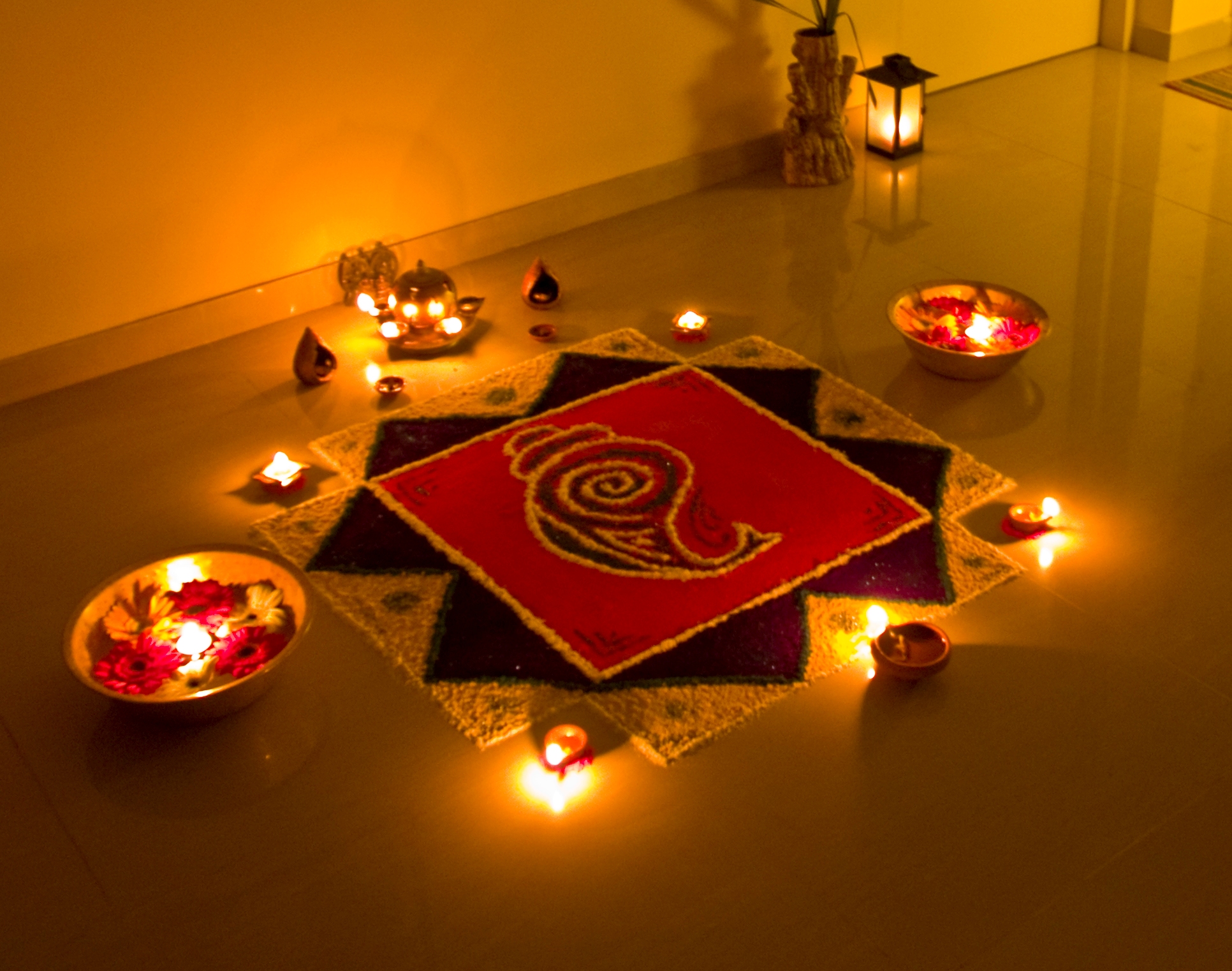
History: The word 'Deepavali' means an array of lights. Deepavali, the festival of lights, is held throughout India. In Kerala, this is celebrated only by Hindus. It is celebrated in commemoration of the destruction of the demon called Narakasura by Lord Krishna. As Lord Krishna killed Narakasura on the Chaturdasi day (the fourteenth lunar day) it is also known as Narakachaturdasi. The people of Dwaraka greeted Lord Krishna with illumination and rejoicing in honour of his victory over Narakasura. The darkness of the Chaturdasi night compelled them to use many lamps on the occasion, and subsequently the illumination became a part of this celebration.
As the light dispels darkness, ignorance is replaced by knowledge. There is a prayer in the Upanishat. 'Thamaso ma Jyothirgamaya' i.e. "carry us from the darkness to light" some people are of the opinion that Deepavali, the festival of lights, symbolises this prayer.
Occurrence : It falls on the preceding day of the New Moon in the Malayalam month Thulam (October-November).
Celebrations: Before sunrise, all in the house have their oil bath and put on new cloths. Sweets are then served followed by bursting of crackers.It is the practice in south India to consume a preparation of dry ginger and jaggery soon after the oil bath on the Deepavali day. Dry ginger and jaggery form the Nivedya (offering) for Dhanwantari, the great exponent of Ayurveda. The Dhanwantari Jayanthi falls on the eve of Deepavali. The separate observance of this day had come to an end and enjoying the preparation of dry ginger and jaggery fallen to succeeding day namely Deepavali.
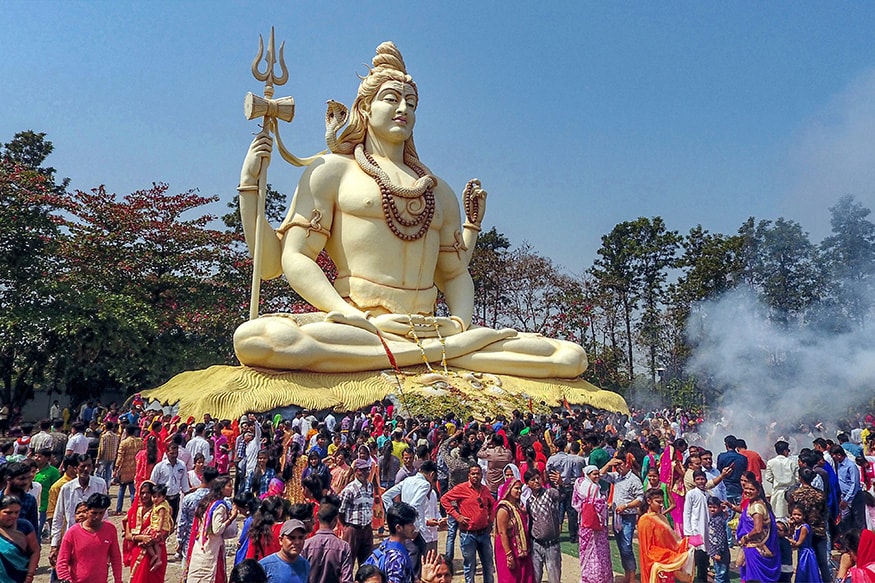
History: The Mahasivarathri is essentially a religious festival unlike the Onam and Thiruvathira. The word means `the great night of Siva. The festival is said to commemorate the day on which Siva protected the world from a total annihilation either by drinking the deadly Kaalakoodum poison which was held up in his neck, or by effecting a healthy compromise between Brahma, the Creator and Vishnu, the Protector.
Occurrence : According to the Sivapurana, it falls on the Krishna Chathurdasi day which is on the fourteenth day during the warning of the moon in the month of Megha, though in some years it may occur in Phalguna also. In Kerala the month of Kumbham is noted for the Sivarathri festival which falls in February -March.
Celebrations: The Mahasivarathri is considered a very important day for fast and Siva worship. Though the observance of Sivarathri rites promises both material comfort in this world and bliss in the other, it is mainly observed for securing the latter, While some Hindus abstain from every kind of food for the whole day, others content themselves with one meal. People cluster round the Siva temple and after bath smear their bodies with holy ashes and keep on reciting the prayers to Siva. Pooja to Siva is kept up all the night. Strict vigil is kept in the holy night. Early next morning people bath once more; worship Siva and return to there are Siva temples where Kavadiyattom is of great significance in the celebration of the Sivarathri festival.
There is no other place in Kerala where Sivarathiri is celebrated on such a grand scale as in Aluva. The celebration of Sivarathri in Aluva is as famous as the festivals like Ashtami at Vaikom, Pooram at Thrissur etc. The celebration of Sivarathri at the Siva temple at Aluva on the sand bank of River Periyar is attended with great eclat. Here the Lingom (idol) of Siva rises out of the sand on the bank of the river. The sand bank is extensive and the pilgrims running into several thousands congregate here. People belonging to all classes, castes and creeds assemble for this festival, some for worship, some for merchandise and some for sight-seeing. There are rows of sheds built where merchants exhibit every kind of merchandise for sale. There are shows, dances etc. meant for keeping the pilgrims awake throughout the night. In addition to the observance of Sivarthri rites, most of the pilgrims offer Bali (sacrifice) to their ancestors in the morning succeeding the holy night.In many respects the Sivarathri festival in Kerala can be considered a miniature Ardha Kumbha Mela held at Thriveni, the confluence of the holy rivers Ganga-Yamuna, and the invisible Saraswathi.
Church Festivals

History: Christmas celebrated to honour the glory of the nativity of Jesus is the most significant and spectacular of Christian festivals.
Occurrence: Christmas falls on 25th December
Celebrations: No other celebration is so enriched with so many customs and ceremonies. There is an array of spectacles like Christmas Star, Christmas tree, the Crib, Christmas cake, Christmas presents and the Christmas Father. The last named is quite a fascinating personage, who claims above all to be the very embodiment of the most vibrant and quintessence of the gayest of all the festivals. Children allowed occupying the central stage, in the enchanted company of Christmas Father, Christmas takes on the look of a festival of children. The mood is set with the advent of the season by the twinkling of Christmas stars and there is no home or shop without the Christmas star, the beautiful pointer to the Babe of Bethlehem. The Christmas tree is a new feature in Kerala, perhaps less than sixty or seventy years old. The crib is a miniature production of the stable where Jesus was born. It developed from the old practice of giving dramatic expression to the events and the surroundings of the birth of Christ. Carols and songs developed from earlier nativity plays have become one of the most cheerful spectacles of the festivities.Priests hold mass in churches three times starting with the first at mid-night. Just before the mid-night mass, an image of the Child is brought by the priest, preceded by rows of Children holding lighted candles that are placed in the crib. The hymn 'Gloria in excelsis Deo' is intoned admidst the explosion of crackers. A sumptuous lunch with rate delicacies is a significant feature of the celebration. Meat forms part of the feast even in rural homes where meat is rarely eaten. Cake has also become common in the villages where women have learnt to make it. In Kerala, X'mas retains its homeliness and expresses itself in the cultural forms of the country without losing what is native to itself.
History: Easter is the oldest Christian festival, as old as Christianity itself. The Central tenet of Christianity is not the birth of Jesus, but his resurrection. Easter derived from this paschal mystery and from the events of Good Friday.
Occurrence: It comes in the month of April - May
Celebrations: The content of Easter was gradually analysed into historical events and each began to be celebrated on a different day. As a result, Easter grew into a Holy Week and came to have a preparatory season to precede and a festive season to follow. Thus we have four distinct periods in connection with the observance of Easter- (i) Lent, the forty preparatory penitential days. (ii) Holy Week including the Thursday, Friday, Saturday and Sunday. (iii) the Octave of Easter (classical time for Baptism) and 4. the paschal season or Easter time extending over forty more days. On Holy Thursday the Lord's supper is held in the evening. The washing of feet is a remarkable trait, emphasising the love for one another. At home there will be the rite of the pashcal bread. After supper, the 'cross cake' is brought out and cut into pieces. A piece is broken, dipped into sauce and handed over to each member of the family in due order. Good Friday is a day of grief when churches are empty and dark. Services are held in the afternoon. In most churches one finds a bitter drink prepared from leaves, vinegar, etc for everyone to taste after the service. Holy Saturday is a day of mourning and wailing. A total silence reigns the church from morning to dusk. But by ten at night the church is full to observe the Easter Vigil. In the gloom which envelops the church, new fire is struck from flint and blessed. A big candle is then consecrated and from it is lighted many candled indicating the resurrection. Bells peal, music fills the air and light floods the hall. Hallelujah is the joyous word of Easter wish.Easter Sunday is a quiet day and the celebrations rather spiritual and inward rather than social and showy. There will be grand dinner at homes and visit of relatives.
Masjid Festivals
History: Bakrid, to be rightly called Idul-Azha or the festival of sacrifice, is the second of the two festivals of Islam. This festival is observed by Muslims all over the world. It is celebrated in commemoration of Abraham's willingness to offer his only son as a sacrifice at God's command.In Kerala as in other parts of the world, this day dawns with the resounding of Thakhir (Allahu Akbar), the declaration that God is great.
Occurrence : It falls on the 10th of Dhul-Hagg, the last month of the lunar year.
History: Idul-Fitr, of late known by the misnomer `Ramadan' is one of the two festivals of Islam.
Occurrence: Ramadan is the ninth month of the lunar year.
Celebrations: During this month the Muslims Observe fast, giving up all kinds of food and drinks during day time, and spend the major part of the night in devotion and prayer. Purification of the body and soul is the main aim of this observance.
When the crescent appears on the western horizon heralding the end of the month of fasting, it marks the beginning of the Idul-Fitr festival. Because this festival is connected with the month of Ramadan, it came to be known as 'Ramadan'. The Idul-Fitr festival starts with the commencement of the first day of the month of `Shawwl'. The first item of the celebration is distribution of food materials to the poor and the deserving. Any person who holds food in excess of the day's need must necessarily make his contribution in accordance with the scales prescribed by Islam. Muslims all over the world celebrate this festival with great eclat and in gratitude to God.
History: It was on this day that God is believed to have created Adam and Eve and that the Pharoah of Egypt and his countrymen were drowned in the Red Sea by the will of the Almighty. Again it was on this day that the most lamentable carnage at Kerala took place in 680 AD when Imman Hussain, the grandson of the Prophet and his men met with their end in an agonising manner. On this day the Jews observe fast. The Prophet enjoined on the Muslims to observe fast on the ninth and tenth of Muharram. It was to commemorate the victory of the Jews over Pharoah that fasting was enjoined upon Muslims on these days. For the Shia Muslims, Muharram is an important occasion for religious ceremony. The Sunni Muslims do not celebrate Muharram, but the devout Muslims among them observe fast.
Occurrence : Muharram, the forbidden month, is the opening month of the Hejira year. The 10th day of the month is celebrated by the Sunnies as well as the Shias all over the world.
Celebrations: Pulikali' or `Tiger-dance' is part of this celebration in Kerala. Some Muslims assume the guise of tiger by painting their whole body to bring out the appearance of tiger, wear masks and parade through streets, playing, dancing and mimicking a tiger. This is done to idealize the valour of Hussain.
History: Muslims all over the world celebrate the birth of the Prophet in various ways. In Kerala the practice of large scale celebration of the Prophet's birthday is of recent origin. Reading what is commonly known as the 'Maulod' which is a short biography of the Prophet written both in verse and prose in the Arabic language has been the common ritual of the day.
Occurrence : Mohammed, the Prophet of Islam, was born on the 20th April, 571 AD
Celebrations: Of late in Kerala, there has developed another practice connected with the Miladi Sherif. Night lectures are organised during the first twelve days of the month when Muslim Ulemas through their discourses enlighten the people on the various aspects of the life of the Prophet. Thus through the celebrations connected with the Miladi Sherif, the Muslim masses get an opportunity to be enlightened on the life and teachings of the Prophet.
The celebration of the Miladi Sherif in certain parts of the State, for instance Ponnani, is marked by busy activity connected with large scale feeding of the poor. Here in the Muslim Centre, one finds that the town is active during the whole night busily engaged in the charitable work of supplying food to the poor.
Recently Miladi Sherif celebration has assumed greater importance in Kerala. On this occasion colourful processions are taken out through the towns reciting Thakbir. These processions finally converge on some central place where public meetings are held these public gatherings are addressed by well-known speakers who deals with the various aspects of the Prophet's life. Such meetings are often attended largely by non-Muslims also.
Other Festivals

Oachira has been famous for long as one of the sacred places of Kerala. Historically too, this place is very famous, for, it was on the plains of Oachira that the much famed battle in the history of Travancore, the battle of Kayamkulam was fought between Marthandavarma the Maharaja of Travancore and the Raja of Kayamkulam. In commemoration of this historic battle 'Oachirakkali' is conducted on the first and second of Midhunam (June-July) every year.
The Oachirakkali was on of the factors that brought fame and glory to Oachira. On the first and second day of Midhunam (June-July) the young and the old, drawn from the two karas lying east and west of Oachira, and forming themselves into two groups, reach the 'Padanilam' and conduct the age-old fencing exercises under the leadership of the elder Kalari Asan. IT is to perpetuate the memory of the great battle fought between the Maharaja Marthandavarma and the Raja of Kayamkulam that the Oachirakali is conducted with much eclat. Thus the Irupathettam Utsavam comes to an end with the Oachirakkali. A big cattle fair is also held as part of the above festival.
|
Jain Festival at palakkad
|
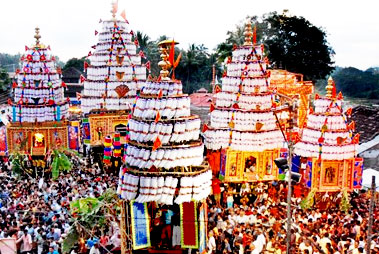
There is an ancient Jain Temple at Jainamedu near the Palakad town. According to a legend, one Sutar, head of the Jains, built this temple 500 years ago for the Jain sage Chandranathaswamy.
Among the Jewish festivals, the Sabbath (Saturday) occupies the pride of place. The Sabbath gives the labourer every week a day of rest and leisure. Passover or the feast of unleavened bread is one commemorating the birth of Israel as a nation and deliverance of the Jews from the Egyptian slavery. It falls in April or May. Pentecost is another Jewish festival held in May-June. It has an agricultural and historical significance. The feast of Tabernacle is another pilgrim festival falling in either September or October. During this feast, Jews set temporary booths covered with palm leaves and decorated with citrus and other fruits. The Jewish New Year falls in September or October. It is not a time for revelry, but a solemn season for self-assessment and judgement in the life of the Jew. The Day of Atonement following the New Year is the most solemn day in the Jewish calendar. Not a morsel of food or a drop of water will pass the lips of the observant Jews from subset of the previous day till after the nightfall of the next day. The Jews will be in the synagogue of devoting themselves to fervent prayers. The Hannukka or the festival of lights is another popular celebration of the Jews.
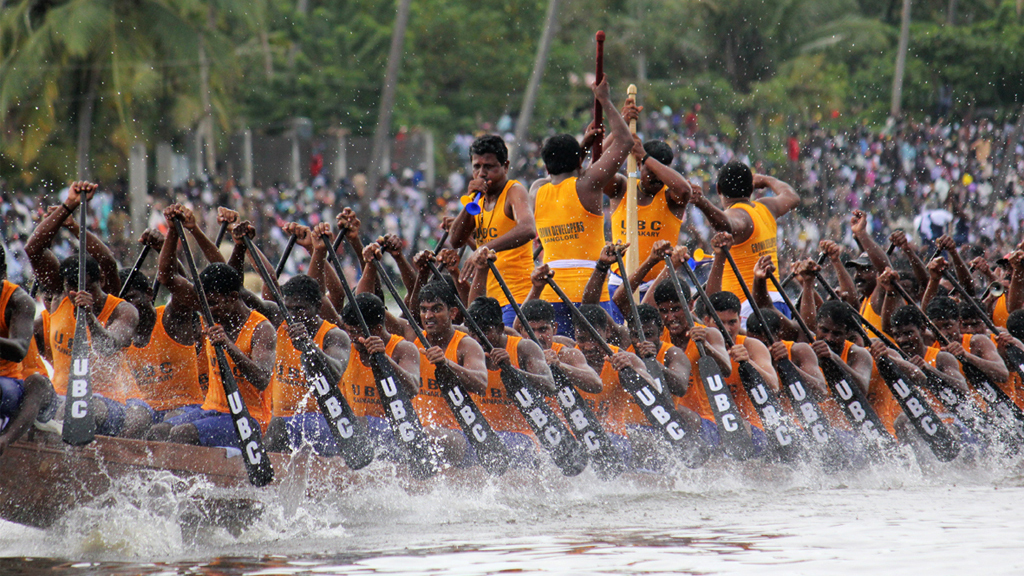
The Nehru trophy regatta at Alappuzha on 14th August every year has become an Independence Day feature. Different types of boats take part in this competition. They include the bean-shaped boats, Kitetailed, curly-headed and so on. Between 30 and 60 metres long with tall, cone-shaped, tapering helms protruding several metres above water and accommodating 100 or more at the oars, these boats of exquisite elegance plough the water with the rhythm of drums and cymbals and legendary songs, typical of Kerala. Above each boat gleam scarlet silk umbrellas as the boats go in procession in the backwaters and rivers of a Kerala, which remind one of the sea-faring and martial traditions of ancient Kerala. The trophy was instituted by former Prime Minister Pandit Jawaharlal Nehru who enthralled by the charm and gaiety of the Kerala Water Carnival.
|
Ottappalam Nercha Festial
|
.jpg)
Juma prayers are held in this mosque on Friday. To Commemorate the death anniversary of a saintly person by name Uthman Auliya an annual Festival is held here in January-February.
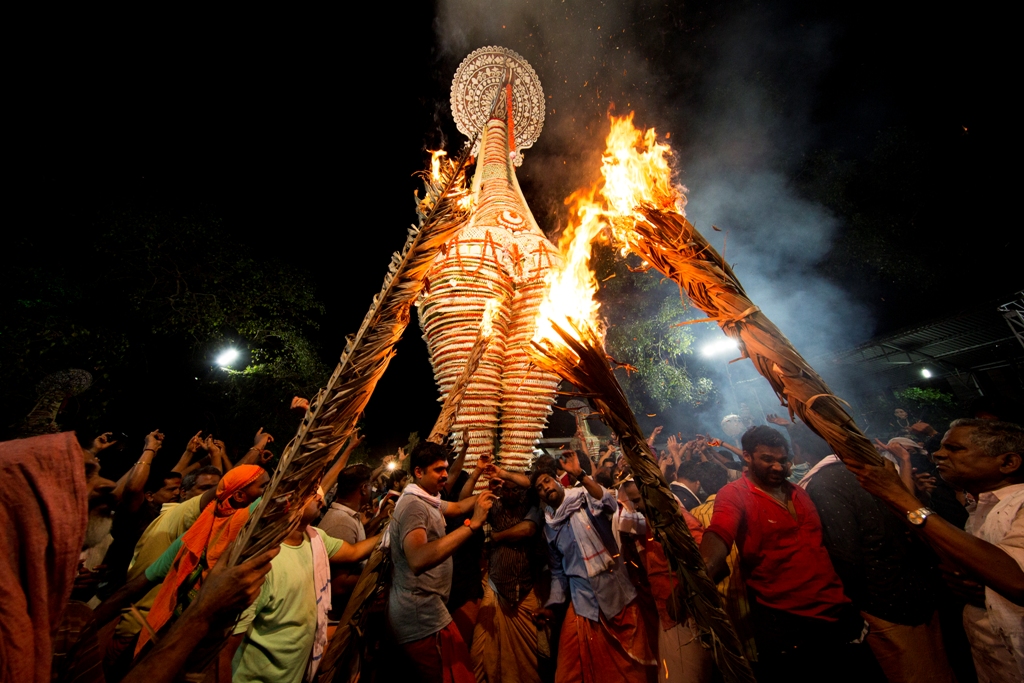
The annual Padayani Utsavam of the Bhagavathikkavu at Nilamperoor, a village in the Kuttanad Taluk on the precincts of Changanassery Municipal town is a festival which symbolises and reflects the tradition and culture of a typical Kerala village. The Padayani Utsavam is celebrated on a grand scale with Kolamkettu (making of effigies) and Kolamthullal (a kind of ritual dance performed by carrying the effigies). The chief kolams displayed are of Siva, Bhima, Ravana, Elephants etc.
|
Vallarpadam Feast and Festival
|
Being an islet Vallarapadam has access only by water. Held in great devotion 'Vallarpadath Amma' is believed to have miraculously saved her devotees several time from violent storms. The feast of Vallarpadath Amma is held every year on September 24 with much fanfare.The celebrations which last for more than a week is accompanied by an unusually big fair. The most important products and articles offered at this fair are country boats and cars, pots and straw mats. The last item finds an important market here as the festival falls in the harvest season.